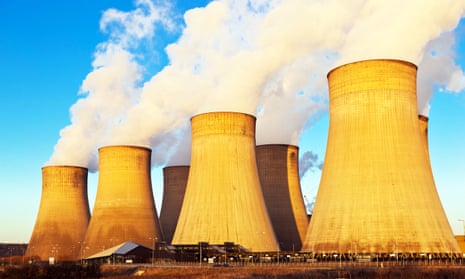Britain’s ability to meet its emissions targets is being challenged by a comeback for coal power stations that threatens to drive up the energy sector’s carbon emissions for the first time in six years.
Coal plants have become more economic to run than their gas counterparts in the past month because wholesale gas prices have hit 10-year highs. A report by Imperial College London said the extra coal-burning had increased emissions by 15% in September, equivalent to an extra 1,000 tonnes of carbon dioxide per hour.
If the trend continues in the coming months, the sector’s emissions would rise by as much as 1.2 million tonnes this year, according to researchers at the university.
The energy sector is the UK’s second biggest emitter after transport. However, it has been the economy’s standout success for cutting emissions in recent years because of the rapid growth in renewables and the phaseout of coal.
A reversal of that success, even if only temporary, could pose a dilemma for ministers, who have to meet legally-binding carbon targets. The UK’s carbon budgets, set by the Committee on Climate Change in order to meet the long-term goal of an 80% cut in emissions by 2050, dictate how much the country can emit over five-year periods.
The UK is due to easily meet its third carbon budget, which runs from 2018-2023, but any prolonged rise in energy emissions would make future budgets harder to hit.
Dr Iain Staffell, the author of the Imperial College London report, said: “If the only thing that has done well starts to backslide, I think that’s going to be a real problem in meeting these [carbon] targets because they’re just ratcheting up and getting more and more difficult.”
The recent increase in coal-burning is likely to continue this year because gas prices are usually higher in winter because of increased demand for heating. Analysts expect gas prices will stay high this winter.
“I think there’s a pretty good worry that we’re looking at up to six months of coal being the cheapest source,” Staffell said.
Consumers are unlikely to benefit from coal being cheaper but coal operators would see their profits boosted this year, he said.
The resurgence represents mixed news for EDF Energy, RWE and SSE as they all operate both coal and gas plants.
However it will be good news for Germany’s Uniper, which operates the Ratcliffe-on-Soar coal power plant in Nottinghamshire, and the energy group Drax, which commissioned the research by Imperial College London. While four of Drax’s six units have converted to biomass, two still burn coal.
The market intelligence firm ICIS said that it expected coal would account for 10.5% of electricity generation this winter, up from 10% last year.
However, it warned that figure could go up significantly if there was a repeat of last winter’s ”Beast from the east” cold spell, or further outages at French nuclear power stations, which the UK relies on via links across the English Channel.
“If similar capacity issues or a cold snap were to be seen again this winter, we could expect the forecast 10.5% share of coal to increase significantly,” the group told the Guardian.
Coal’s comeback off high gas prices comes despite two coal power stations shutting later this month and EU carbon prices at 10-year highs. The UK has yet to say whether it will stay within the EU emissions trading system (ETS) when it leaves the EU but the energy industry has lobbied the government to stay in the scheme, which is the world’s biggest carbon market.
Even if the UK leaves the ETS, coal operators would still have to pay the UK’s tax on dirty energy generators, called the carbon price floor, which has been frozen until 2025.
The last time coal enjoyed the highs of recent weeks was the short-lived windfall for coal plant owners during the “Beast from the East” in February and March. During the cold snap, sudden and high demand for heating caused gas prices to surge, making coal power stations competitive against gas ones.
However, coal remains on the way out in the UK. The government is committed to phasing out coal power by 2025 to meet its climate goals and the viability of most of the remaining plants rests on securing government subsidies to provide backup power at times of need.
